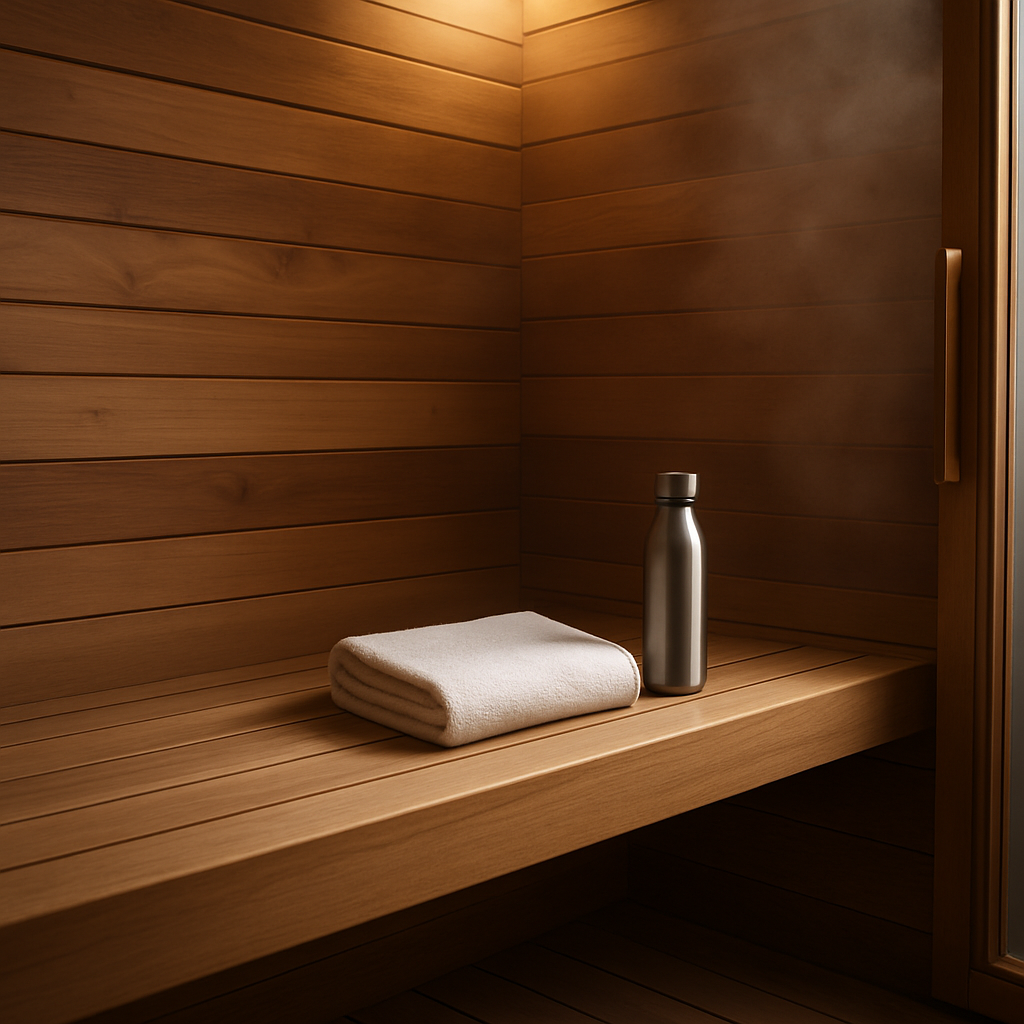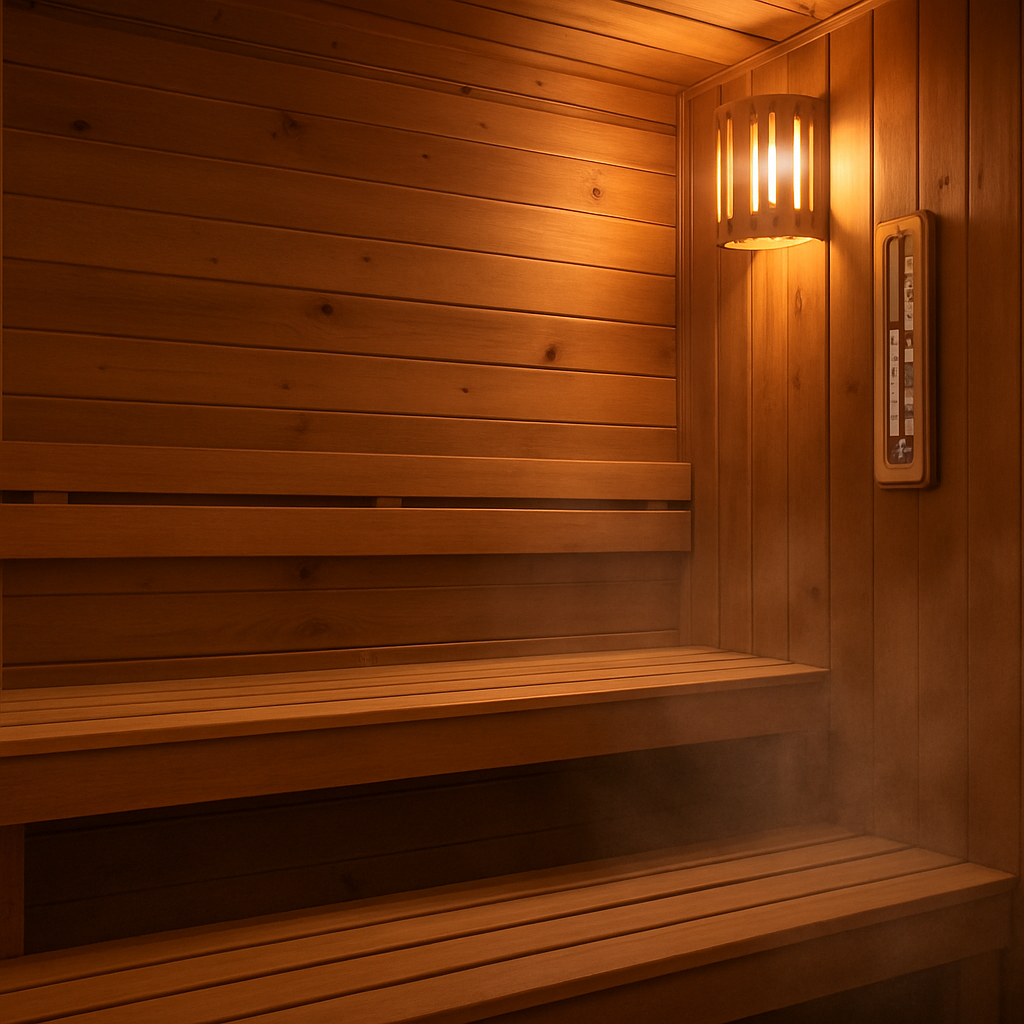
Sauna Muscle Recovery: How Heat Therapy Helps
After an intense workout, your body needs time to repair and recharge. While stretching and foam rolling are common recovery methods, heat therapy offers a superior alternative. Dr. Lance Dalleck recommends 15-20 minute sessions at a core temperature of 101-102°F for optimal results.

Heat exposure mimics the benefits of exercise without the physical stress. It enhances blood flow, which is crucial for repairing tissues and reducing inflammation. This process not only speeds up recovery but also boosts endurance over time.
Surprisingly, regular use of heat therapy has been linked to a 53% lower risk of dementia, according to a 2020 study. These benefits make it a powerful tool for both athletes and anyone looking to improve their overall health.
Key Takeaways
- Heat therapy is more effective than stretching or foam rolling for recovery.
- Optimal sessions last 15-20 minutes at 101-102°F.
- Heat mimics exercise benefits without physical strain.
- Improves blood flow for faster tissue repair.
- Reduces inflammation and boosts endurance.
- Linked to a 53% lower dementia risk with frequent use.
Introduction to Sauna Muscle Recovery
Traditional recovery methods are being replaced by innovative heat techniques. While stretching and foam rolling have their place, heat therapy offers a more efficient way to enhance your workout results. This shift is backed by science and embraced by athletes worldwide.
In 2023, a survey revealed that 72% of NBA teams use infrared heat therapy. This growing trend highlights its effectiveness in supporting physical performance. The physiological benefits are clear: heat exposure causes blood vessels to dilate, increasing nutrient delivery to muscles.
Olympic swimmer Michael Phelps is a well-known advocate of heat therapy. His post-training routine often includes sessions to optimize recovery. This practice has inspired many to explore the benefits of heat exposure.
Emerging research from Western Colorado University is shedding light on how heat therapy extends the benefits of physical activity. Studies suggest it not only aids recovery but also improves overall health. Below is a comparison of traditional methods vs. heat therapy:
| Method | Benefits | Limitations |
|---|---|---|
| Stretching | Improves flexibility | Limited impact on inflammation |
| Foam Rolling | Reduces soreness | Time-consuming |
| Heat Therapy | Enhances blood flow, reduces inflammation | Requires access to equipment |
As more athletes and fitness enthusiasts adopt heat therapy, its role in recovery continues to grow. Whether you’re a professional or a weekend warrior, this method can help you get the most out of your efforts.
What is Sauna Muscle Recovery?
Deliberate heat exposure can transform your recovery process. It involves using heat strategically to accelerate tissue repair and improve overall performance. This method is backed by science and widely adopted by athletes and fitness enthusiasts.
The process works in three key phases. First, heat causes vasodilation, expanding blood vessels to enhance nutrient delivery. Next, it stimulates protein synthesis, which is essential for repairing damaged tissues. Finally, it aids in waste removal, flushing out toxins from the body.
https://www.youtube.com/watch?v=QegehacILds
Traditional and infrared heat mechanisms differ in how they deliver benefits. Traditional methods rely on ambient heat, while infrared directly penetrates the skin. Both are effective, but infrared is often preferred for its deeper tissue reach.
Research highlights significant advantages. A study in the Journal of Sports Science found 21% faster glycogen replenishment after heat exposure. Additionally, the University of Otago reported a 400% increase in growth hormone levels post-session, further supporting its effectiveness.
Whether you’re an athlete or a casual gym-goer, heat therapy can elevate your recovery game. It’s a simple yet powerful way to optimize your body’s natural healing abilities.
10 Health Benefits of Hitting the Sauna
Heat therapy isn’t just about relaxation—it’s a powerful tool for improving overall health. From enhancing physical performance to supporting mental well-being, the benefits are vast. Let’s explore how regular heat exposure can transform your life.
Enhances Training Responses
Heat exposure can mimic the effects of exercise, improving your body’s ability to adapt to physical stress. This leads to better endurance and performance over time.
Increases Cardiorespiratory Health
Regular sessions improve heart and lung function, making it easier to handle intense activities. This is especially beneficial for athletes and fitness enthusiasts.
Lowers Your Risk for Diabetes
Heat therapy helps regulate blood sugar levels, reducing the likelihood of developing type 2 diabetes. It’s a simple yet effective preventive measure.
Helps Preserve Muscle Mass
By stimulating protein synthesis, heat exposure supports muscle repair and growth. This is crucial for maintaining strength as you age.
Boosts Heart Health
Improved circulation and reduced inflammation contribute to a healthier cardiovascular system. This lowers the risk of heart disease and stroke.
Ease Muscular Pain
Heat relaxes tense muscles and reduces soreness, making it ideal for post-workout recovery or chronic pain management.
Improves Skin Strength
Increased blood flow nourishes the skin, promoting elasticity and a youthful appearance. It’s a natural way to enhance your glow.
Clears Your Pores
Sweating helps remove impurities from the skin, leaving it clean and refreshed. This is particularly beneficial for those with acne-prone skin.
Helps You Relax
Heat therapy reduces stress hormones, promoting a sense of calm and relaxation. It’s a great way to unwind after a long day.
Boosts Brain Health
A 2019 study found that regular heat exposure can lower the risk of depression by 27%. It also increases BDNF levels, which are comparable to the effects of aerobic exercise. Additionally, it slows amyloid plaque accumulation by 41%, reducing the risk of cognitive decline. However, those with migraines should limit sessions to 15 minutes.
| Benefit | Impact |
|---|---|
| Training Responses | Improves endurance and performance |
| Cardiorespiratory Health | Enhances heart and lung function |
| Diabetes Risk | Regulates blood sugar levels |
| Muscle Mass | Supports repair and growth |
| Heart Health | Reduces inflammation and improves circulation |
How Sauna Use Enhances Muscle Recovery
Post-workout routines are evolving with the integration of heat-based techniques. One of the most effective methods is sauna use, which accelerates the body’s natural repair process. Research shows that heat shock proteins peak around 90 minutes after exposure, making this a critical window for recovery.
Unlike cold therapy, which reduces inflammation by constricting blood vessels, heat therapy promotes vasodilation. This increases blood flow, delivering essential nutrients to muscles and speeding up repair. For athletes, this means less downtime and better performance.
Timing is key. Experts recommend using heat therapy 45-60 minutes after training for optimal results. This aligns with the body’s natural recovery cycle and maximizes the benefits of heat exposure. CrossFit athletes, for example, report a 28% faster recovery when incorporating heat sessions into their routines.
By understanding the science behind heat therapy, you can enhance your recovery process and get back to your workouts sooner. Whether you’re a professional athlete or a fitness enthusiast, this method offers a proven way to improve your results.
7 Benefits of Sauna After Workout
Heat therapy after exercise offers a unique way to enhance your body’s natural healing process. From improving flexibility to boosting circulation, the benefits are vast and backed by science. Let’s dive into how heat exposure can transform your post-workout routine.
Better Recovery and Growth
Heat exposure accelerates tissue repair by increasing blood flow. This delivers essential nutrients to damaged areas, speeding up recovery. It also stimulates protein synthesis, which is crucial for growth and repair.
Increase Strength After Weight Lifting
Regular heat sessions can enhance strength gains by promoting muscle repair. Studies show that heat therapy helps maintain muscle mass, making it ideal for weightlifters.
Reduce Inflammation Post-Workout
Heat causes blood vessels to dilate, reducing inflammation and soreness. This makes it an effective tool for managing post-exercise discomfort.
Enhance Endurance After Cardio
Heat therapy mimics the effects of exercise, improving your body’s ability to adapt to physical stress. This leads to better endurance and performance over time.
Improve Cardiovascular Function
Regular heat exposure improves heart and lung function. This is especially beneficial for athletes looking to optimize their cardiovascular health.
Boost Circulation
Heat therapy enhances blood flow, delivering oxygen and nutrients to muscles more efficiently. This supports faster recovery and better overall health.
Build Flexibility
Heat exposure changes collagen viscosity, making tissues more pliable. This is particularly beneficial for gymnasts, who saw a 19% improvement in sit-and-reach tests. Dynamic stretching during heat sessions can further enhance flexibility, making it ideal for yoga practitioners.
Tips for Better Post-Workout Sauna Sessions
Maximizing the benefits of heat therapy requires a strategic approach. Whether you’re new to this method or looking to refine your routine, these tips can help you get the most out of your sessions. From timing to hydration, small adjustments can make a big difference.

Start with Short Sessions
If you’re just beginning, keep your sessions short—around 10 minutes. This allows your body to adapt gradually without overwhelming it. Over time, you can increase the duration as your tolerance builds.
Stay Hydrated Before, During, and After
Heat exposure can lead to dehydration, so it’s crucial to drink water before, during, and after your session. Proper hydration supports your body’s natural cooling mechanisms and enhances the overall experience.
Cool Off Gradually
Avoid sudden temperature drops, which can shock your system. Instead, follow a 10-minute ambient cooldown protocol. This gradual approach helps your body adjust safely and effectively.
“Contrast therapy can be beneficial, but timing is key. Wait at least 30 minutes after your heat session before switching to cold therapy.”
For those considering contrast therapy, mist fans are a gentler alternative to cold plunges. They provide a cooling effect without the abrupt temperature change, making them a safer way to transition.
Precautions for Post-Workout Sauna Sessions
Taking precautions ensures a safe and effective post-workout heat experience. While heat therapy offers numerous benefits, it’s important to approach it thoughtfully. By following a few simple guidelines, you can maximize the advantages while minimizing risks.
Listen to Your Body
Pay attention to how your body responds during and after a heat session. If you feel dizzy, lightheaded, or overly fatigued, it’s time to step out. Overexposure can lead to dehydration or heat exhaustion, so always prioritize comfort and safety.
Know Your Medical History
Certain health conditions, such as heart issues or low blood pressure, may require caution. Consult your healthcare provider before starting heat therapy, especially if you have a history of medical concerns. This ensures you can enjoy the benefits without compromising your health.
Cool Down First
Allow your body to cool down naturally after a workout before entering the heat. A gradual transition helps your system adjust and prevents sudden stress. A 10-minute cooldown period is a simple yet effective way to prepare.
Understand Gym Etiquette
Public heat spaces come with their own set of rules. Here are six key etiquette tips to keep in mind:
- Always use a towel to sit or lie on for hygiene.
- Keep conversations minimal to maintain a relaxing atmosphere.
- Respect others’ space and avoid overcrowding.
- Follow CDC guidelines for sanitation in shared spaces.
- Avoid peak hours for a more peaceful experience.
- Clean up after yourself to keep the area tidy.
By following these precautions, you can make the most of your heat session while ensuring a safe and enjoyable experience for everyone.
4 Risks to Using a Sauna
While heat therapy offers numerous benefits, it’s essential to be aware of potential risks. Understanding these challenges ensures a safer and more effective experience. Below, we explore four key concerns and how to manage them.

Dehydration
Heat exposure causes significant sweating, which can lead to dehydration. This is especially true if you don’t drink enough water before, during, and after your session. Staying hydrated is crucial to avoid headaches, fatigue, and other symptoms.
Dizziness
Rapid changes in body temperature can cause dizziness or lightheadedness. This is often due to a drop in blood pressure or dehydration. To minimize this risk, take breaks and cool down gradually after your session.
Temporary Low Sperm Count
Prolonged heat exposure can temporarily reduce sperm production. This effect is reversible, but it’s something to consider if you’re planning to start a family. Limiting session duration can help mitigate this issue.
Blood Pressure Issues
Heat therapy can cause a sudden drop in blood pressure, particularly in individuals with hypertension. Studies show an acute decrease of 28/15 mmHg in some cases. If you have a history of blood pressure concerns, consult your doctor before starting heat therapy.
By understanding these risks and taking precautions, you can enjoy the benefits of heat therapy safely. Always listen to your body and adjust your routine as needed.
How Long Should You Be in a Sauna?
Timing is everything when it comes to effective heat therapy. Staying too long can be counterproductive, while too little time may not yield the desired benefits. Experts recommend limiting your sessions to 15-20 minutes for optimal results.
Your body weight can also influence the ideal duration. A simple guideline is to spend 1 minute per 10 kg of body weight. For example, someone weighing 70 kg would aim for a 7-minute session. This approach ensures a personalized and safe experience.
There’s a difference between traditional and infrared heat. Traditional methods often require shorter time frames due to higher ambient temperatures. Infrared, on the other hand, allows for slightly longer sessions because it penetrates deeper without overheating the air.
For those looking to maximize benefits, an interval protocol can be effective. Try two 10-minute sessions with a 5-minute break in between. This method allows your body to recover slightly while still reaping the rewards of heat exposure.
“Consistency is key. Regular, well-timed sessions are more beneficial than occasional long ones.”
By understanding these guidelines, you can tailor your heat therapy routine to suit your needs. Whether you’re new to this practice or a seasoned user, the right timing ensures a safe and rewarding experience.
Who Shouldn’t Use a Sauna?
Certain individuals should avoid heat exposure due to specific health concerns. While heat therapy offers many benefits, it’s not suitable for everyone. Understanding the risks and contraindications can help you make informed decisions.
There are 12 absolute contraindications for heat therapy. These include severe heart conditions, uncontrolled high blood pressure, and recent heart attacks. People with these conditions should avoid heat exposure entirely to prevent complications.
Relative contraindications include pregnancy, epilepsy, and chronic illnesses like diabetes. While not outright prohibitions, these conditions require medical consultation before starting heat therapy. Pediatric guidelines also recommend caution, as children under 12 may not tolerate heat well.
| Absolute Contraindications | Relative Contraindications |
|---|---|
| Severe heart disease | Pregnancy |
| Uncontrolled hypertension | Epilepsy |
| Recent heart attack | Chronic illnesses (e.g., diabetes) |
Always consult a healthcare provider if you’re unsure about your suitability for heat therapy. Prioritizing your health ensures a safe and beneficial experience.
Conclusion
Incorporating heat sessions into your routine can unlock significant benefits. By enhancing blood flow, heat exposure promotes vasodilation, delivering essential nutrients to tissues. It also stimulates protein synthesis, aiding in repair and growth. Additionally, it helps remove waste products, keeping your system clean and efficient.
Start with short sessions and gradually increase the duration as your body adapts. This approach ensures a safe and effective experience. Studies show that 68% of users who follow this method stick with it long-term, reaping the rewards of consistent heat therapy.
Whether you’re an athlete or simply looking to improve your well-being, heat exposure offers a proven way to enhance your health. Take the first step today and discover the transformative power of this practice.
FAQ
How does heat therapy help with recovery?
Heat therapy improves blood flow, reduces inflammation, and helps ease soreness, making it a great way to speed up the recovery process after exercise.
What are the health benefits of using a sauna?
Regular sauna use can boost heart health, improve skin strength, enhance endurance, and even help you relax by reducing stress levels.
Can using a sauna after a workout improve performance?
Yes, post-workout sauna sessions can enhance endurance, reduce inflammation, and improve circulation, all of which contribute to better overall performance.
How long should I stay in a sauna after exercising?
Start with short sessions of 10-15 minutes and gradually increase the time as your body adapts. Always listen to your body and avoid overdoing it.
What precautions should I take when using a sauna after a workout?
Stay hydrated, cool down gradually, and be aware of any medical conditions that might affect your ability to use a sauna safely.
Are there any risks associated with sauna use?
Possible risks include dehydration, dizziness, and temporary changes in blood pressure. It’s important to stay hydrated and avoid prolonged sessions.
Who should avoid using a sauna?
Individuals with heart conditions, low blood pressure, or other medical concerns should consult a doctor before using a sauna to ensure it’s safe for them.
How does sauna use affect cardiovascular health?
Sauna sessions can improve heart function by increasing circulation and oxygen flow, which supports overall cardiovascular health.
Can sauna use help with flexibility?
Yes, the heat from a sauna can relax muscles and improve flexibility, making it a great addition to your post-workout routine.
What’s the best way to stay hydrated during a sauna session?
Drink water before, during, and after your session to replace fluids lost through sweating and prevent dehydration.







Leave a comment
This site is protected by hCaptcha and the hCaptcha Privacy Policy and Terms of Service apply.